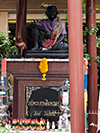|
Bodindecha (บดินทรเดชา)
Thai. Name of a prominent ruler of the
Rattanakosin period during the reign of King
Rama III. He held the title of
Chao Phraya and from 1827 to 1849 he held the post of Samuha Nayok, i.e. the High Chancellor of the Interior Command of the northern districts of
Siam. He was born in
Bangkok on 13 January 1776 and given the name Singh Singhaseni. He was the son of Chao Phraya Abhayraja (อภัยราชา), nicknamed Pin (ปิ่น), who had served as the Samuha Kalahome i.e. the High Chancellor of the Interior Command of the southern districts. In his youth, Singh served as a royal page to Prince Phra Nang Klao and when the latter was crowned King, referred to by his crown title
Rama II, Singh was transferred to serve under the Viceroy in the
Front Palace. In 1809, he joined his lord in the campaign against the Burmese invasion of
Thalang and afterward was promoted to the rank of
Phraya and put in charge of police and later agriculture. Yet, in 1816, Singh was demoted again and jailed facing treason charges after an incident in which he accidentally crossed his barge in front of one of the
Royal Barges (fig.) during the
Royal Barge Procession (fig.). Only through the intervention of Prince
Phra Nang Klao he was pardoned, and when the latter in 1824 ascended the throne as Rama III, Singh was reinstated as Phraya and put in charge of conscription. In 1826, he was assigned to Southern Laos and
Champasak to squash a rebellion against Siamese rule. In 1827, the then Samuha Nayok fell ill and died, and King Rama III elevated Singh to the position of Samuha Nayok. Upon his final return to the capital, King Rama III officially invested Singh with the title of Chao Phraya Bodindecha Samuha Nayok in which the name Bodindecha derives from the king's personal name, i.e.
Chetsadabodin (fig.). Chao Phraya Bodindecha passed away in Bangkok on 24 June 1849 during the Cholera epidemic which claimed around 30,000 lives and lasted for six decades, returning annually with every dry season. He was 73 years old and was cremated in 1850 at
Wat Saket, a cremation paid for by the King himself.
回






|

